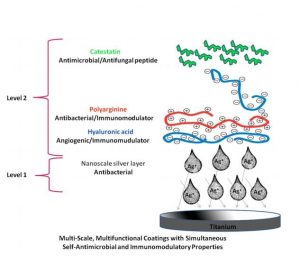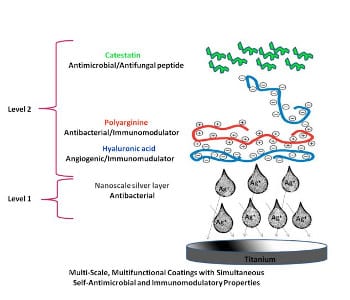 Infections with bacteria, viruses or yeasts and adverse immune reactions after surgery are common problems encountered with protheses and implants, e.g. pace-makers. They can lead to a reduced functionability or even rejection of the implants. For these reasons developing surface coatings with antimicrobial and anti-inflammatory properties is of primary importance. A group of researchers has created a multifunctional coating based on bioactive agents, which addresses all these problems at once.
Infections with bacteria, viruses or yeasts and adverse immune reactions after surgery are common problems encountered with protheses and implants, e.g. pace-makers. They can lead to a reduced functionability or even rejection of the implants. For these reasons developing surface coatings with antimicrobial and anti-inflammatory properties is of primary importance. A group of researchers has created a multifunctional coating based on bioactive agents, which addresses all these problems at once.
Up to date titanium was the element of choice for coatings, because of its biocompatibility and reliable mechanical properties. However multiresistent pathogens frequently developed on the Titanium surface, which cannot be treated with classical antibiotics.
A group of scientists around Philippe Lavalle designed a polyelectrolyte multilayer film based on polyarginine (PAR) as a polycation and hyaluronic acid (HA) as a polyanion. PAR acts as a cell penetrating protein (CPP) and can be used as an intracellular delivery agent. HA is a biopolymer with angiogenic and anti-inflammatory properties. In addition, catestatin (CAT), a natural CGA derived peptide, was used as antimicrobial peptide (AMP). AMPs disrupt membrane integrity of a broad spectrum of microbes. A balanced interaction with the key innate immune cells of the tissue environment is important for the acceptance of implants. In earlier work the group found out that CAT can penetrate neutrophils. Moreover, CAT can modulate the secretion of innate immune components such as cytokines by macrophages. Finally, adding a nanoscale layer of silver to the system lead to longer antimicrobial activity.
The authors could show that PAR/HA and PAR/HA+CAT have suppressive effects on the production of macrophage cytokines involved in chronic inflammation. Antibacterial and antifungal activities of the new system were successfully tested against S. aureus, C. albicans and A. fumigatus.
The authors designed a multilayer PAR/HA+CAT coating film based on several multifunctional natural biomaterials. Taking advantage of the synergies of its components, it improves acceptance and functionability of implants.

















